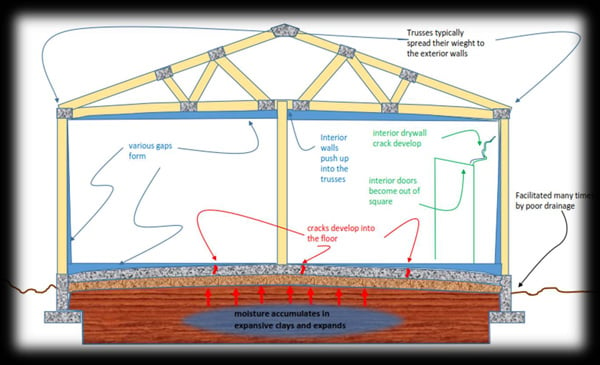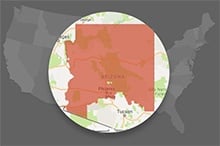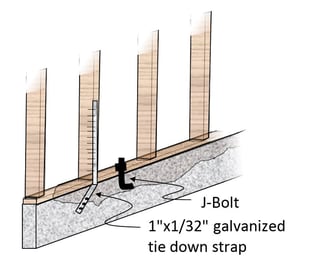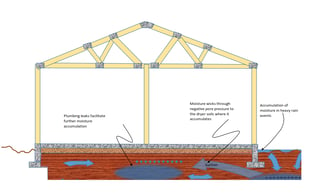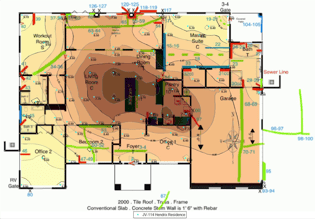Foundation Heave vs. Foundation Settlement
What is the difference?
Foundation Heave is the uplift of the foundation caused by wet, expanding soil beneath a slab floor. This uplift occurs when it is dry outside your foundation and wet underneath it.
It’s easy to misdiagnose foundation uplift problems because the edges of a slab appear to be pushed downward as the center of the slab is pushed up (as shown in the drawing above). The soil around your foundation can dry out easily because it’s exposed to the sun, the air and to plants that suck up moisture.
But these drying forces aren’t in play underneath a slab. Over time, moisture can easily accumulate under the slab from rain, roof runoff, leaks in nearby storm drains and other sources. So the expanding clay pushes up, causing central sections of the slab to move upward as well.
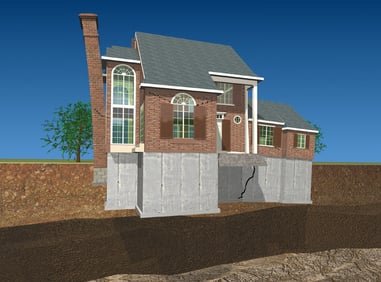 Foundation Settlement occurs when soils deform under the load weight of the foundation and structure built on top of it. Signs of a settling foundation can be very subtle at first -- many homeowners can go months, or even years, before noticing a crack in their foundation. The long-term damage from foundation settlement, however, is ongoing and will lead to more severe foundation problems.
Foundation Settlement occurs when soils deform under the load weight of the foundation and structure built on top of it. Signs of a settling foundation can be very subtle at first -- many homeowners can go months, or even years, before noticing a crack in their foundation. The long-term damage from foundation settlement, however, is ongoing and will lead to more severe foundation problems.
Symptoms of a Foundation Problem
- Stair-step cracks in brick or concrete block foundation walls
- Leaning, tilting chimneys
- Cracks around doors and windows
- Jamming, sticking doors and windows
- Cracks in a concrete slab floor
- Cracks in drywall
Free Initial Foundation Inspections for Arizona Homeowners
Are you seeing any of these symptoms of a foundation issue in your home? We can help...

Damaged Doors & Windows
An opening cut in any wall is a weak point, so signs of foundation settlement often show up around door and window openings.
Doors and windows frames may be racked out of square. Cracks may extend from the corners above doors and windows. Doors may separate from the framing or exterior finish. Other signs of foundation settlement include sticking or jamming doors and windows, and locks that stop working.

Stair-Step Cracking
Stair-step cracking is one of the surest signs of foundation settlement and is very common in brick and concrete block walls.
As the settlement continues, vertical cracks may widen or become uneven as wall sections tilt away from each other, indicating more severe displacement.
Keep an eye out for cracks that are wider at the top than at the bottom, as this is a sign of advancing settlement.

Tilting Chimneys
Tilting chimneys that are separating from the home are one of the most intimidating and dramatic signs of a settling foundation.
Sometimes a chimney is built on a footing that is not connected to the house foundation. The enormous weight of a chimney can make it even more at risk of settlement.

Slab Floor Cracking
Cracks in your concrete floor slab can be a sign of foundation settlement, but they may also be a sign that the slab floor alone has settled.
There are times when your slab floor may sink or lift independently of the foundation walls, damaging the floors but not necessarily the foundation walls themselves.

Drywall Cracks
Cracks in drywall throughout the house are reliable indicators of foundation settlement. Cracks will often be larger and more obvious in the home's upper levels.
Typical drywall cracks during foundation settlement are commonly located at the corners of doors and windows and along drywall seams. Drywall tape can also be a good indicator, especially if it's ripping or coming loose. Drywall cracks can also be a sign of sinking crawl space supports, sinking floors, and heaving floors.







